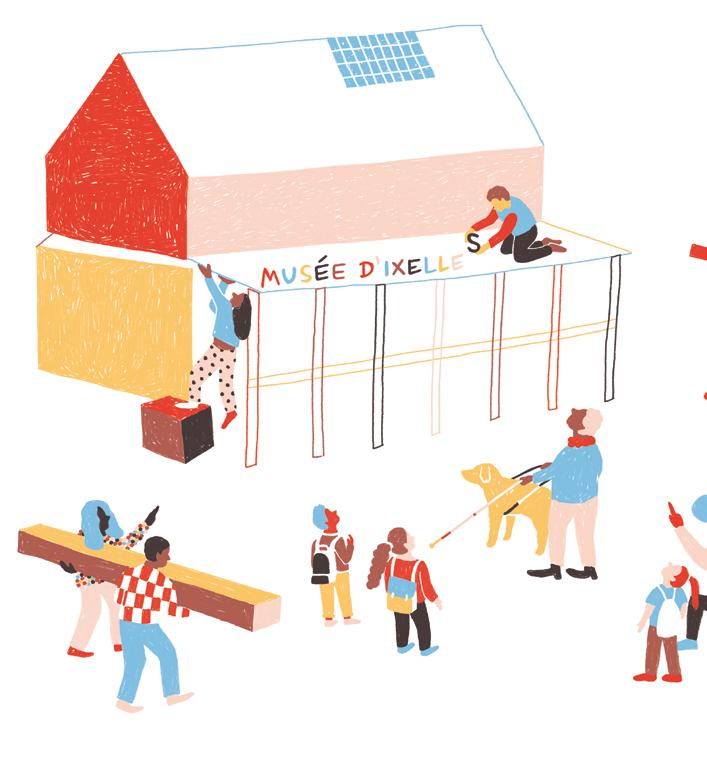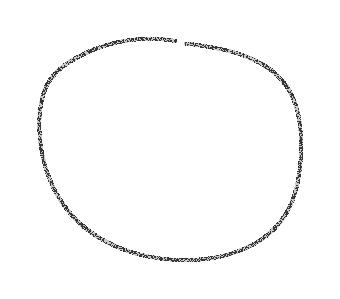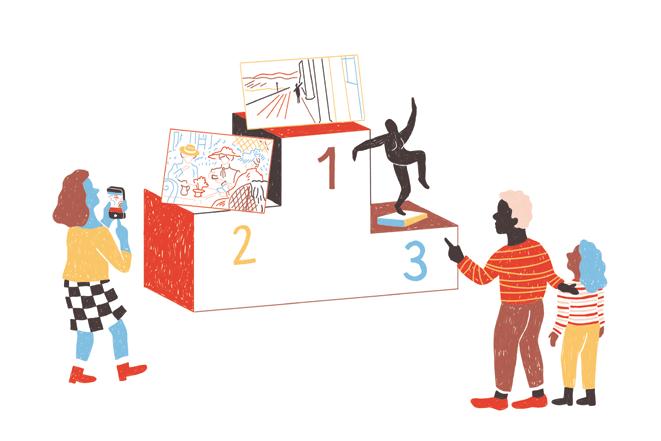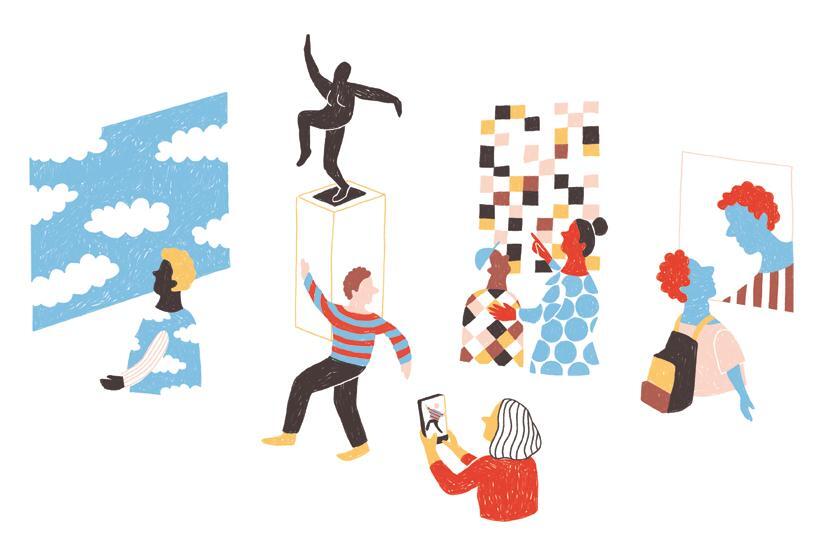




Thinkingtogeth ertheIxellesMuseum of tomorrow
2021—2022
Table of contents First and foremost p. 2 A consultation campaign for a museuma strange idea? p. 3 A three-act campaign p. 4—5 Never without my PAC! p. 6—7 To each stage, its revelations p. 8—15 Online survey: what you told us p. 8—11 Forum meeting: what you also told us p. 12—13 Focus groups: ultimate revelations p. 14—15 You agree on this p. 16—21 Time to conclude p. 22—23
Two years of enthusiastic meetings, discussions and reflection between the Musée d'Ixelles (Ixelles Museum) – closed for renovation – and public groups, some of whom were already familiar with the place while others had just come into the picture…
A project that certainly deserved an attractive campaign booklet!
This document, which is deliberately brief, is intended above all to keep a record of the progress made and share the main learnings of our collective adventure as widely as possible.
It is a condensed version of a far more detailed report that the museum team can now use as a reference tool to enrich its vision and strategic plan for the reopening scheduled for 2025.
We hope that you - like us - will enjoy reading it and that you will not hesitate to spread the word. It is a token of the museum team's appreciation for the efforts made by all these people, aged from 9 to 99+ – there are almost 2,000 of them! – who undertook, in one way or another, to collectively think about the Ixelles Museum of tomorrow.
We would like to thank you all very much indeed!
A consultation campaign for a museum - a strange idea?
Well, not really… 1
To invite you to express your views
Firstly, because we felt that you would have a lot to say and that it would have been a shame not to hear your thoughts.
To involve you in the conceptualisation of the museum of tomorrow
Because this museum will be yours and we would like you to feel at home here.
To specify your expectations
It's always good to know what you like about the Ixelles Museum... if you are already familiar with it.
Or if not, why you never come here... And whether we could change your mind.
To come up with recommendations on participatory approaches
It's all very well to become involved in the life of the museum, but let's face it, sometimes it's not clear how to go about it, or what we should ask of you. This campaign also provided an opportunity to look at the much talked-about issue of public participation! By trying it out, but also by discussing it with you.
3 2 First and foremost
OBJECTIVE
OBJECTIVE
2
OBJECTIVE
4
OBJECTIVE 3
ATo make sure you told us “everything”, we devised a threeact campaign, so that there would be something for everyone.


The online survey Focus groups


A museum is not something that can be redesigned just with the faithful few!
For those of you who love filling in questionnaires, especially when there are few distractions in the middle of Covid!
If this is you, rest assured, you were not alone!
The forum meeting
For those who want to change the world (or the museum) while chatting over a drink.
Almost 100 people took part in this second phase of the consultation process. Most of them had already completed the online survey, but not all.
In the midst of the pandemic, a welcomed return to the normality of in-person exchanges allowed us to organise this meeting at the museum.
It provided an opportunity to explore two specific themes in more depth: Public commitment and The museum as a living space.
19+20JUNE 2021

This last act in the campaign involved sending out a personalised invitation to groups of people who do not yet visit the museum. So they had a lot to teach us about how to make it more welcoming and attract a more diverse range of visitors.
We met with children, young people, people with disabilities, intermediaries from the social sector and minority communities, representatives of the African community in Matongé and the Ixelles Consultative Council for European Affairs (CCAE), which is made up of residents of Ixelles who are active in the expatriate community.
For these focus groups, the exchange began with a short visit behind the scenes of the museum, to discover the works kept in the storerooms.
And there, more often than not, the magic worked: questions were asked and little by little, tongues were loosened. It was time for us to listen!
Around 1,671 people told us their wildest dreams about the Ixelles Museum. And you clearly applied yourselves, since you spent an average of 11 minutes on our 31 questions! NOVEMBER2021—JUNE2022


4 5 1 2 3
MARCH-APRIL2021
three-act campaign
A campaign without a PAC (Public Advisory Committee) is like Tintin without Snowy, Bob without Bobette. It means missing out on much-needed support when you know you are embarking on an adventure with a very uncertain outcome.




Consulting the public means stepping out of your comfort zone and taking the risk of raising unfulfilled expectations.
So in order to face this adversity, it’s a good idea to surround yourself with a panel of citizens who are benevolent but also ready to put you back on the right track when needed.
A whole series of criteria were defined to put together a mixed panel representing a balance of men and women with a wide range of generations, family situations, cultural and/or neighbourhood user profiles, backgrounds and mother tongues (French, Dutch, Italian, Spanish, Wolof, Arabic and more).
The role of the PAC was to offer a constructive and creative view of the development, follow-up and finalisation of the whole consultation process.
From reviewing the online survey forms to analysing the results of the different stages in the campaign and reflecting on the way in which the results should be presented, the PAC proved to be a valuable ally, providing cohesion to the various phases of the process.
The PAC also acted as a relay to circulate the survey and to invite people to take part in the forum meeting or contribute to the focus groups. Some members were also approached by the press and took on the role of ambassadors for the museum.
The PAC met at six crucial points in the campaign over a two-year period.
Of the original thirteen participants, ten are still fully committed to the adventure. Three of them had previously never had any direct contact with the museum team.
Never without my PAC!
W N S E
6 7
Each of the three phases of the campaign yielded very specific results, with particular attention being paid to certain issues.
ONLINE SURVEY: WHAT YOU TOLD US







But who are you?
The very format of the survey and the way it was distributed - mainly via the museum's own channels and those of the Ixelles municipalityprovided an opportunity for those already interested in the museum to express their views.






And a remarkable number of you did so, proving that the museum can rely on a loyal and committed public.
83% of you had already visited the Ixelles Museum in the past.



The typical respondent was a Frenchspeaking woman from Ixelles aged over 50 who regularly visits exhibitions.





It is important to take this information into account when looking at the following results.
Among the groups generally well represented at the museum, it is worth noting two major absentees from the survey:
— young people, who are virtually not present at all until the age of 23, although the museum welcomes many school groups and families.
— occasional visitors (event-goers, tourists, cultural groups, etc.) who could not really be questioned, as the museum was closed.
WOMEN 66% OTHER 1%
MEN 33% GENDER
+50 Y/0 59%
AGES
25—49 Y/0


38% -24 Y/0 3%
OCCASIONAL 3% REGULAR
VISITORS
59% FREQUENT 38%
BELGIUM
97% BRUSSELS
PROVENANCE

82% WALLONIA
10% FLANDERS 8%
8 9
To each stage, its revelations
Your

Ixelles Museum in a nutshell

Among the aficionados, 80% of you state that you would recommend the Ixelles Museum to your friends. When you talk about it, you say: — it is small, but beautiful and interesting — that you appreciate its collection of Belgian art and its high-quality exhibitions — as well as its human side



Your Mona Lisa at the Ixelles Museum
In the museum's collection, you particularly appreciate the attention paid to modern art and its beginnings (late 19th and early 20th century). The three artworks that you mentioned most were:
39%
36%
fascinatingauthentic thorough
surprisingwelcoming municipal proximity posters

It's a secret place where you forget everything else and come out, with stars in your eyes. interesting small beautiful quality
charming calm intimate rich
original splendid serene intriguing sensitive
unique heritage Ixelles
fresh quirky
brussels inspiring
human belgiancollection

34%
accessible pleasant varied friendlydynamic
open exhibition
cosy cosy lively
hidden nice discovery
Léon Spilliaert, The night, 1908
Théo Van Rysselberghe, Tea in the garden, 1903
Rik Wouters, The mad maiden, 1912
FORUM MEETING: WHAT YOU ALSO TOLD US
Following the analysis of the results of the online survey and a brainstorming session with the PAC, we opted to put forward the following themes as topics for discussion at this meeting:
The museum as a living space
Museums today are no longer seen as "mere" exhibition and conservation spaces, but as places that really live, offering multiple experiences and stimulating dialogue.
While the presence of a café, meeting and relaxation areas (garden, auditorium, etc.) are part and parcel of this vision, you also point out that art and artists still occupy a central place in the museum.
Of all the activities you suggest, those that create connections between past and present - within the exhibitions and collections - also help to restate the role of the museum and its task of conveying culture, history, art and more.
The discussions about the concept of a "living space" led you to express multiple and sometimes conflicting needs in terms of visitor experience.
While some call for peace and quiet, a place for introspection, where people can switch off, others would like to see festive events, interaction and participation. Digital is mentioned by some, but fiercely rejected by others.



The difficulty of responding to all these wishes at the same time was noted during the discussions. You therefore recommend that we provide spaces and times with different atmospheres. Staggered hours for certain groups (schools, hypersensitive people, etc.) can also be considered.
Good communication will be crucial here.
is no typical museum visitor profile. There are several such profiles, which overlap. People may correspond to one profile at certain times, and another at other times, with wishes that may differ considerably.
Audience engagement
To our great surprise - and pleasure - many of you said in the survey that you wanted to get involved with the museum. So practically speaking, how? That is the question we asked you!


To engage with us, you need us to be clear about our needs.
You are not so much looking for occupation as for the feeling of making a real contribution to the museum. And you prefer short-term assignments, even if it
means participating in several of them.
You can see yourself doing practical tasks (helping out at events and so on), testing our new facilities or promoting the museum among your own networks and friends.
You don't necessarily want to be paid, but you would appreciate gestures of recognition (privileged access to an event, tickets, discovering the life of the museum behind the scenes, etc.).
12 13
̋There
—Reflection of a young girl in a focus group
FOCUS GROUPS: ULTIMATE REVELATIONS
In the various focus groups, you made a number of recommendations to improve the accessibility of the museum.

Your opinion is all the more valuable as you had never been to the Ixelles Museum before.

Once you are there, you usually find the museum quite interesting and most of you think that it would be good for the next generations to enjoy it.
But for you to come back or bring your friends, you wish to be able to better relate with the programme and the collection, and you would also like for your interests and questions to find their place within our walls.
Your message is quite clear: diversity of audiences means diversity of proposals. To reach their audiences, these proposals will also need to be accompanied by personalised communication. You recommend interdisciplinary approaches, sensitive experiences, encounters with artists, outreach actions, collaborations with external partners, different discourses... to extend the channels of approach to our collections.
To avoid presuming your expectations and choices, it is essential that we keep in touch, that we regularly invite you to discuss our programme or to co-create projects.



The museum is not part of our culture.
— Focus group "Diversity”
Not everyone reacts to a work of art in the same way, the emotional value varies according to each individual.
— Focus group "Diversity”
14
"In
like".
15
the museum, like don't
Focus group "Children"
A place for everyone: the accessible museum

Whether you are a fan of the museum or not, you consider that its accessibility to all is a real priority.
For you, this means above all:
— A warm welcome (multilingual, personalised, no queuing, etc.)
— Accessible rates adapted to different categories of visitors
— Extended opening hours (regular late-night openings, etc.)
— Improved visibility of the museum, among other things, through:
● Greater communication (social networks, advertising, partnerships, etc.) and a better targeting of the different audiences
● Better signage in the city
● Clarification of the name by adding a baseline
— Itineraries adapted to people with special needs (disabilities, hypersensitivity, etc.), but also inclusive approaches to collections and exhibitions, taking multiple sensitivities into account.
Many of you appreciate discovering art through stimulation of several senses. This multi-sensory approach also seems to be an opportunity to bring different audiences together.
Similarly, ensuring the readability of written material (sufficiently large font, widely accessible language) is a good example of a point of attention that can benefit everyone.

To choose sometimes means to forsake, but that does not prevent us from improving!
Among all your suggestions, choices will necessarily have to be made according to their relevance, the museum's missions, their feasibility
and also the means available (human and financial).
One example is the recurrent request for more parking space, even though the current ecological challenges call for soft mobility in the city.
However, you can count on us to pay particular attention to our communication on accessibility for people with reduced mobility and on the existing parking areas around the museum.
16 You agree
this
on
A place of life and wonder: a stimulating visitor experience
A museum visit is a holistic experience. The addition of a café and a shop, as well as the new green area announced for the reopening, are therefore generating a lot of enthusiasm on your part.


Regardless of your age or physical condition, many of you have told us that a visit to the museum can be a physical strain.
You would enjoy having a place to rest and breathe. Creative minds also suggest experimenting with new ways of wandering through the rooms, suggesting activities that put the body in motion in a different way.
In addition to improved visitor comfort, you are asking for a rich and diversified cultural programme.
It would be useful to communicate more and in a more targeted way about the offer we are already developing. It seems that the information has not always reached you.
Among the activities that you are most unanimous about, you mention:
— Discovering the works at your own pace or taking advantage of different degrees of reading and interpretation

— Interactive, playful or multi-sensory visits, performances, creative workshops

— Explore the museum's backstage areas: visit the storerooms, talk to the staff
Meeting artists, taking part in conferences, debates... which ties in with the next point.
18 19
A place for reflection, encounter and discovery: the museum as forum
The museum as "forum" open to the many voices of visitors offers:
— the discovery of artists, upcoming or well-known, with the possibility of entering into a dialogue with them or having information on their creative process (videos, sketches)
— interdisciplinary encounters with the visual arts as a starting point
— lectures and art history courses
— exhibitions/conferences/debates on current topics and/or social issues
Ixelles artists were very present during the consultation and clearly expressed their wish to be exhibited.
However, the Ixelles Museum does not aim to become a museum dedicated to Ixelles art, as the strength and coherence of its collection lies above all in its broad representation of modern and contemporary Belgian art.
Two concrete suggestions emerged from the consultation to meet this expressed need:
— Serve as a promotional relay to other structures in Brussels that promote local talent: Boondael chapel, Ixelles Academy, Ixelles artists' trails, etc.
— Develop more targeted communication when Ixelles artists are exhibited at the museum or enter the collections, which is regularly the case.


The Ixelles Museum frequently invites contemporary artists to exhibit or interact with the collections. Many of you are unaware of this. This should be systematically communicated to teachers and students, by building on partnerships, sometimes already existing with universities, art schools, etc.

20 21
We made you wait a little while before delivering the results of this consultation. The exercise of reporting is delicate and deserved some time to reflect.
To measure the progress we have made together, it is enlightening to go over the initial objectives one by one:
To specify your expectations
You want a museum where pleasure and wonder are the keynotes. This requires dynamic, innovative, interactive, inclusive, interdisciplinary programming, offering several ways of accessing art and taking into account sometimes diametrically opposed wishes.
In order to evolve with its time, the Ixelles Museum must assert itself as a space of discovery, a meeting place and a "forum" open to multiple voices where art remains at the heart.
To
invite you to express your views
Whether you are familiar with the museum or have yet to be convinced, you have done so in large numbers and with great relevance.
Multiple identities and expectations are just waiting to be expressed if we invite them to. It is up to us, more than ever, to ensure that this happens!
To involve you in the conceptualisation of the museum of tomorrow
It is reassuring to note that the guidelines recommended in our scientific and cultural plan - an essential document defining the identity and strategic direction of the museumare reinforced by your vision of the museum, its values and its DNA.
The Ixelles Museum must remain a place on a human scale, close to you.
You are attached to its collection of Belgian art and its variety of exhibitions of international standard, but you also appreciate its local roots.
Nevertheless, it would benefit from greater visibility.
Its accessibility to a diverse public is also one of your priorities.
Not all of your suggestions can be fulfilled as soon as the museum reopens and choices will have to be made, but several widely demanded features will be implemented: the presence of a café, a shop, a new relaxation area (garden), etc.
To come up with recommendations on participatory approaches
Both what you have told us and the experience of this campaign have enabled us to identify a number of conditions that are essential to the success of a participatory project:
— time - to allow for a highly personalised and flexible approach to the project and its participants
— establishing a mission with a precise duration and objectives

— assessing what the museum is really able to delegate and communicate this clearly;
— incorporating the voice of the public from the very start of the process (thanks again to the PAC!).
22 23 2 OBJECTIVE 3 OBJECTIVE 4 OBJECTIVE
Time to conclude
1 OBJECTIVE
A project of the Ixelles Museum. On the initiative of Christos Doulkeridis, Mayor; Ken Ndiaye, Alderman for Culture and Museum and members of the College of Mayor and Aldermen of Ixelles. With the support of the Wallonia-Brussels Federation. And the participation of the consulting firm 21 Solutions.

© All rights reserved - Musée d'Ixelles
Illustrations: Fanny Monier
Graphic design: Ekta
Published in April 2023
This brochure is published for non-commercial purposes. It may not be sold. No part of this brochure may be reproduced or adapted in any way.
Publisher: Christos Doulkeridis, chaussée d'Ixelles, 168
B-1050 Brussels
Public consultation
TELL US EVERYTHING ! 2021 — 2022
This booklet recounts two years of meetings, discussions and passionate cogitations between the Ixelles Museum — closed for renovation — and public groups, some of whom were already familiar with the place while others had just come into the picture.
It is a condensed version of a more detailed report that the museum team can now use as a reference tool to enrich its vision and strategic plan for the reopening of the museum scheduled for 2025.





































































